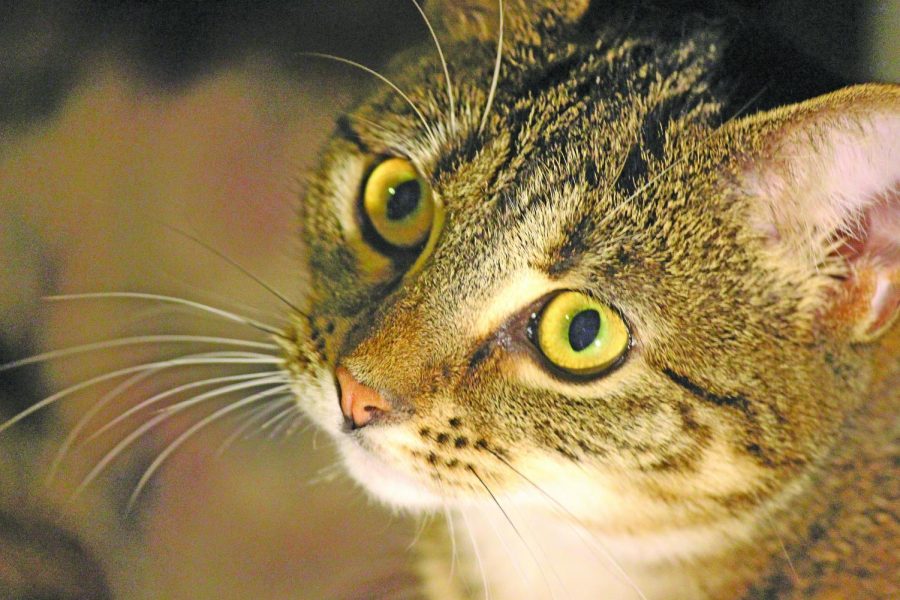How to play with cats: the art of heavy petting
I walked into my friend’s apartment with the goal of preparing crepes on a Sunday morning, green cast iron crepe pan in my backpack and a jug of milk in my hand. I was greeted with the smell of fresh cat litter in the three trays, two of which are a new and temporary addition to the household. The smell was followed by the small chirping of one of the “foster” kittens as he jetted down the stairs to great me. He is a cross-eyed therapy cat in training and he doesn’t know it yet. I followed him up the stairs to find the older resident-cat at the top. He was visibly perturbed by the addition of both visiting felines and wanted little to do with either of them.
If you’re one of those people who thinks that cats are just insane and unpredictable and thus unenjoyable, I highly recommend that you learn how to play with the cats that you encounter. Playtime is vital to understanding a feline’s personality because all cats are different in their play style and the toys that they prefer. For example, my own cat greatly dislikes any physical activity that doesn’t include killing something and crunching it down on my mother’s pillow at about 3 am. Her preferred toy is a hair tie, but she won’t just play with one on her own. She only plays if the hair tie is placed on the floor and kicked for her to run after at full speed.
The two kittens that have found temporary sanctuary at my friend’s apartment are very easy to play with, as kittens usually are. Just about anyone can play with a kitten. They are easily distracted and attracted to shiny, noisy things. Be careful, they don’t all know how to retract their claws yet so some of them are sharp.
Felix is one of these sharp-clawed kittens, but he is very easy to interact with. His favorite toy is a horrendous ball of what appears to be thin, shiny, plastic lattice-work, tubing that is tied together on a string at the end of a stick. In other words, the most god-awful cat toy that mass-production has ever managed to spew into existence. He is also attracted to my shorter necklace because it’s shiny and makes a great deal of noise. These toys make sense for Felix because he is part Siamese and is thus cross-eyed. He does not see as well as most cats, but he can see his abomination of a cat toy and he can hear the coins on my necklace. His play style is chase and leap.
Holding a cat’s interest depends on the movements of the person at the other end of the toy. The easiest way to play with Felix is to drag that toy along the ground and yank it up into the air as soon as he’s about to catch it because he follows it. He will launch himself after it and catch it midair.
The other “foster” kitten, Apollo, is another matter. Black and overly thumbed, he is timid and enjoys the shadows. He is also a little instigator and learning how to get along with the other cats in the house by trying to fight them. He and Felix initially hated each other but learned how to interact a little through watching each other play. Playing with Apollo requires a little more tact as he is slightly older than Felix and more adept at the concept of stalking. He likes slow moving toys that will inch around and stop allowing him to pounce. He is also partial to feathers and the tails of other cats. A good technique to use with him is to drag whatever toy is being used under a piece of furniture so that he can dive for it.
Then there’s Bowie: smelly, soft, delightfully salty Bowie. This cat’s attention is difficult to hold because he is a strong and stubborn individual who likes to do his own thing. He is also very wary of the kittens. Being able to get his attention off of them and onto something else for an extended amount of time was a puzzle. That said, I discovered that if there is a piece of fabric on the floor and a toy being dragged below it, his interest immediately peeks. He watches as the little lump shifts under the fabric and listens as it drags on the floor and then he’ll pounce and dig.
Feline communication can be difficult to understand because it’s all body language. If a cat is looking at a toy and not moving after it, it doesn’t mean that they’re disinterested. If the cat’s pupils dilate when the toy is moved a certain way that is the best way to continue to move it. Cats look away from things that they are disinterested in and their interest can be difficult to keep for more than a few minutes. That said, play time is a great way to get to know any cat better.






